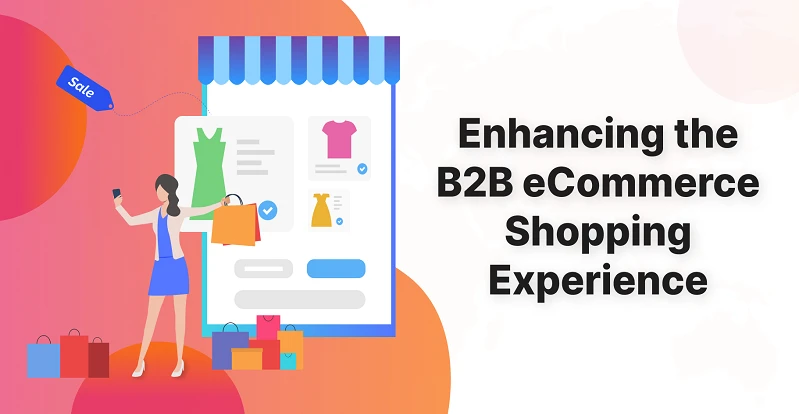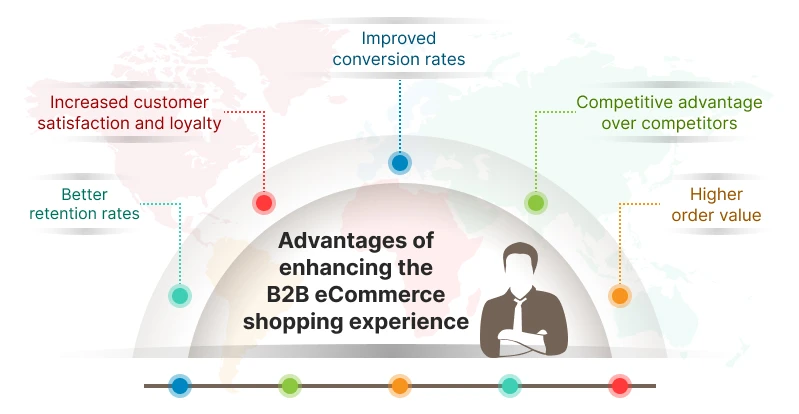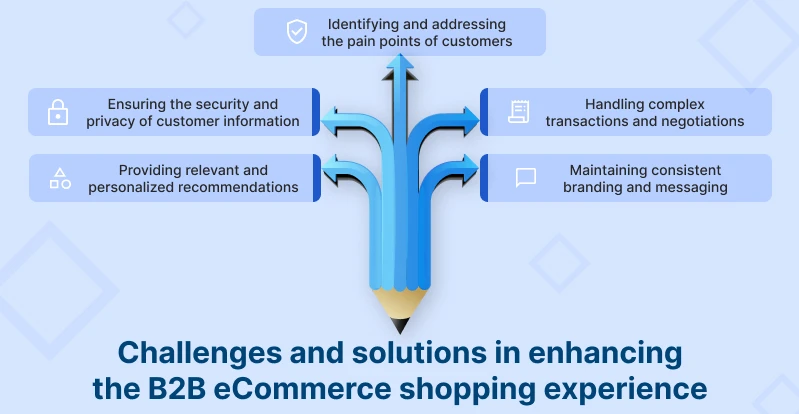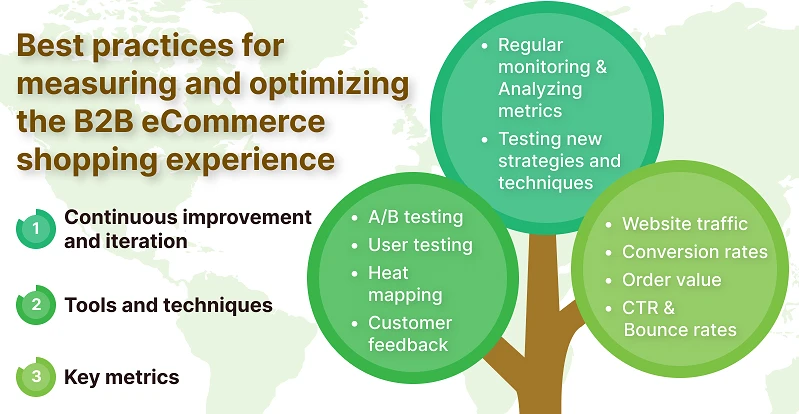- All
- B2C eCommerce
- B2B eCommerce
- Composable Commerce
- Headless Commerce
- Magento
- Digital Asset Management
- Jewelry and Diamond
- Digital Experience Platform
- Mobile Commerce
- Web Application
- Digital Marketing
- Replatforming
- Grocery App
- Furniture and Home Decor
- Digital Commerce
- Adobe Commerce
- Shopify
- Product Information Management
Enhancing the B2B eCommerce Shopping Experience

In today’s digital age, B2B eCommerce has become an increasingly important channel for businesses to buy and sell products and services online. The success of a B2B eCommerce platform largely depends on the customer’s shopping experience. In fact, the best B2B eCommerce customer shopping experience can make a significant difference in customer loyalty, retention rates, and overall revenue growth.
In this blog, we’ll explore the key components of the B2B eCommerce shopping experience and discuss strategies for enhancing it. We’ll also look at the advantages of a good shopping experience and the challenges and solutions to achieve it. Additionally, we’ll provide the best practices in customer experience for measuring and optimizing B2B eCommerce shopping. By the end of this blog, you’ll clearly understand how to improve your B2B eCommerce platform and provide an exceptional shopping experience to your customers.
So, let’s dive in!
Understanding the B2B eCommerce shopping experience
Understanding the B2B eCommerce shopping experience is crucial for businesses looking to enhance their online sales channels. The B2B eCommerce shopping experience refers to the entire process that a B2B customer goes through while purchasing products or services from an online B2B platform.
Key components of the B2B eCommerce shopping experience
The key components of a good B2B eCommerce shopping experience include a personalized and customized shopping journey, a user-friendly interface with easy navigation, mobile responsiveness, efficient checkout, and payment options, and timely customer service. These components must work together seamlessly to provide a frictionless and enjoyable shopping experience for the customer.
Importance of understanding the B2B eCommerce shopping experience
Understanding the B2B eCommerce shopping experience is the foundation for enhancing it and lies in its potential to improve B2B customer satisfaction and loyalty, increase conversion rates, and drive higher order value. Businesses that can provide their customers with a smooth and personalized shopping experience will gain a competitive advantage over their rivals. In addition, by understanding the customer’s pain points, preferences, and behavior, businesses can better tailor their eCommerce platform to meet their needs.
Businesses that can provide a seamless and personalized shopping experience to their customers can gain a competitive edge in the crowded online marketplace. The next section will discuss strategies for enhancing the B2B eCommerce shopping experience.
Strategies for enhancing the B2B eCommerce shopping experience
Enhancing the B2B eCommerce customer shopping experience requires a comprehensive strategy that incorporates several key components. By focusing on these components, businesses can provide their customers with a personalized and user-friendly experience, ultimately driving higher conversion rates and revenue growth. Let’s take a closer look at some strategies:
Personalization and customization
Providing a personalized shopping experience is essential for B2B eCommerce platforms. 80% of customers are more likely to make a purchase when brands offer personalized experiences. This can include customized product recommendations, personalized content based on the customer’s browsing history, and tailored pricing options based on the customer’s purchase history. By personalizing the shopping experience, businesses can increase customer satisfaction, loyalty, and retention rates.
User-friendly interface and navigation
A user-friendly interface with easy navigation is crucial for a seamless shopping experience. The interface should be intuitive, easy to navigate, and optimized for different screen sizes. Clear and concise product descriptions, images, and videos should also be included to help the customer make informed purchasing decisions.
Mobile responsiveness
With the increasing use of mobile devices for online shopping, B2B eCommerce platforms must be mobile responsive. Therefore, the platform should be optimized for mobile devices, including smartphones and tablets, with easy navigation, fast page loading times, and a streamlined checkout process. According to statistics, if users have a negative mobile experience, 40% of them are likely to switch to a competitor. Surprisingly, a significant 84% of users have encountered challenges while trying to complete a transaction on their mobile devices.
Easy checkout and payment options
The checkout process should be quick, easy, and secure, with multiple payment options available. This includes credit card payments, PayPal, and other digital payment options. To reduce cart abandonment rates, businesses should also consider offering guest checkout options and providing clear and transparent shipping and return policies.
Efficient customer service
Providing timely and efficient customer service is essential for enhancing the shopping experience. This includes providing multiple channels for customer support, such as live chat, email, and phone support. Businesses should also consider implementing a knowledge base or FAQ section to help customers find answers to their questions quickly.
Integrating social proof and reviews
Integrating social proof and customer reviews can help build trust and credibility with potential customers. This includes featuring customer reviews and ratings on product pages and social media platforms. Businesses can also consider implementing a referral program to incentivize customers to refer their colleagues or partners to the platform.
Incorporating these strategies with the help of a B2B eCommerce website development services into your B2B eCommerce platform can enhance the shopping experience and ultimately lead to higher conversion rates, increased customer satisfaction, and revenue growth. It’s essential that businesses continually measure and optimize their shopping experience to ensure that it meets the evolving needs of their customers.
Advantages of enhancing the B2B eCommerce shopping experience

Enhancing the B2B eCommerce shopping experience has numerous advantages for businesses. By providing a personalized, user-friendly, and efficient shopping experience, businesses can improve customer satisfaction and loyalty, increase conversion rates, and ultimately drive revenue growth. Let’s take a closer look at some of the advantages of enhancing the B2B eCommerce shopping experience:
Increased customer satisfaction and loyalty
Providing a seamless and personalized shopping experience can increase customer satisfaction and loyalty. By offering tailored pricing, product recommendations, and efficient customer service, businesses can create a positive experience that encourages customers to return and make repeat purchases.
Improved conversion rates
A user-friendly and efficient shopping experience can also improve conversion rates. By simplifying the checkout process and providing multiple payment options, businesses can reduce cart abandonment rates and increase the likelihood of customers making a purchase.
Higher order value
Enhancing the shopping experience can also lead to higher-order values. For example, businesses can encourage customers to purchase more products and increase their overall order value by providing personalized product recommendations and tailored pricing options.
Better retention rates
A good shopping experience can also lead to better retention rates. By providing efficient customer service and offering personalized promotions and discounts, businesses can encourage customers to return and make repeat purchases.
Competitive advantage over competitors
Providing a superior shopping experience can also give businesses a competitive advantage over their competitors. By offering personalized product recommendations, efficient checkout processes, and exceptional customer service, businesses can differentiate themselves from their competitors and attract and retain more customers.
In today’s highly competitive B2B eCommerce landscape, providing a seamless and personalized shopping experience is essential for businesses looking to stand out from the competition. By incorporating the strategies discussed earlier in this article and continuously measuring and optimizing the shopping experience, businesses can enjoy the advantages of enhanced customer satisfaction and loyalty, improved conversion rates, higher order value, better retention rates, and a competitive advantage over their competitors.
Challenges and solutions in enhancing the B2B eCommerce shopping experience

Enhancing the B2B eCommerce shopping experience can be challenging, but there are solutions that can help businesses overcome these challenges. Let’s take a closer look at some of the challenges and solutions in enhancing the B2B eCommerce shopping experience:
Identifying and addressing pain points
One of the biggest challenges in enhancing the B2B eCommerce shopping experience is identifying and addressing pain points that customers may encounter. To overcome this challenge, businesses should conduct thorough research to understand their customers’ needs and pain points. Then, by addressing these pain points and offering solutions, businesses can improve the overall shopping experience.
Ensuring the security and privacy of customer information
Another challenge in B2B eCommerce is ensuring the security and privacy of customer information. To address this challenge, businesses should invest in secure payment gateways and implement encryption protocols to protect sensitive customer data.
Handling complex transactions and negotiations
B2B transactions can be complex, involving negotiations and custom pricing structures. To address this challenge, businesses can use digital tools and platforms that allow for easy negotiation and customization while also providing transparent pricing and contract terms.
Providing relevant and personalized product recommendations
In B2B eCommerce, providing relevant and personalized product recommendations can be challenging due to customers’ diverse needs and preferences. To overcome this challenge, businesses can use data analytics and machine learning algorithms to analyze customer behavior and preferences and offer tailored product recommendations based on their needs.
Maintaining consistent branding and messaging
Finally, maintaining consistent branding and messaging across different channels and touchpoints can be challenging in B2B eCommerce. To address this challenge, businesses should develop a clear brand identity and messaging strategy and use tools and templates to ensure consistency across all channels.
While enhancing the B2B eCommerce shopping experience can be challenging, there are solutions available to help businesses overcome these challenges. By addressing pain points, ensuring security and privacy, handling complex transactions, providing personalized recommendations, and maintaining consistent branding and messaging, businesses can create a seamless and personalized shopping experience that drives customer satisfaction, loyalty, and revenue growth.
Best practices for measuring and optimizing the B2B eCommerce shopping experience

Measuring and optimizing the B2B eCommerce shopping experience is crucial for ensuring its success and effectiveness. In order to achieve this, businesses need to understand the key metrics for measuring the shopping experience and utilize the appropriate tools and techniques to optimize it.
Key metrics for measuring B2B eCommerce shopping experience
Key metrics for measuring the B2B eCommerce shopping experience include website traffic, click-through rates, bounce rates, conversion rates, and average order value. These metrics provide valuable insights into the effectiveness of the website design, user experience, and marketing efforts. By regularly monitoring these metrics, businesses can identify areas for improvement and implement changes to enhance the shopping experience.
Tools and techniques for optimizing the B2B eCommerce shopping experience
Tools and techniques for optimizing the B2B eCommerce shopping experience include A/B testing, heat mapping, user testing, and customer feedback. A/B testing involves creating two different versions of a webpage and measuring their performance to determine which one is more effective. Heat mapping involves analyzing user behavior on a webpage to identify areas of interest and potential issues. User testing involves gathering feedback from actual users to identify pain points and areas for improvement. Finally, customer feedback can be collected through surveys or reviews, providing valuable insights into customer preferences and needs.
Importance of continuous improvement and iteration
It is also important for businesses to continuously iterate and improve the B2B eCommerce shopping experience. This involves regular monitoring and analyzing metrics, testing new strategies and techniques, and implementing changes based on customer feedback. By continually improving the shopping experience, businesses can enhance customer satisfaction, increase conversion rates, and improve retention rates.
Measuring and optimizing the B2B eCommerce shopping experience is crucial for its success and effectiveness. Businesses should focus on key metrics, utilize appropriate tools and techniques, and continuously iterate and improve the shopping experience to enhance customer satisfaction and drive business growth.
Trends in B2B eCommerce shopping experience
In today’s digital age, the fundamentals of the B2B customer journey of eCommerce shopping experience have become essential to the business world. It has revolutionized the way businesses interact and purchase products from each other. B2B eCommerce refers to the buying and selling of goods and services between businesses through an online platform. This process offers various benefits, such as faster transactions, increased accessibility, and cost efficiency.
One of the most significant trends in the B2B eCommerce shopping experience is the shift towards providing a customer-centric approach. Companies are now focusing on creating a personalized experience for their clients, which includes customized product recommendations, easy navigation, and simplified checkout processes. This approach ensures customers have a smooth and hassle-free shopping experience, leading to higher customer satisfaction rates and repeat business.
Another important trend is the use of AI and machine learning algorithms to predict customer behavior and provide relevant product recommendations. These algorithms analyze customer data, such as purchasing history and online behavior, to provide a more personalized shopping experience.
A great example of a B2B digital customer experience is Amazon Business, which provides a wide range of products, easy payment options, and customized pricing for business customers. This platform also allows businesses to create multiple user accounts and track their purchases, making it easier to manage their expenses.
The future of B2B eCommerce is bright, with the industry expected to grow rapidly. Businesses will need to adopt new technologies and strategies to remain competitive in this ever-changing market. With the right approach, the B2B eCommerce shopping experience can provide businesses with a significant advantage in today’s digital landscape.
Conclusion
Enhancing the B2B eCommerce shopping experience is crucial for businesses looking to thrive in today’s digital marketplace. But you’ll have to understand what the b2b eCommerce customer shopping experience is before you start something on your own. By focusing on key components such as personalization, user-friendly interface, mobile responsiveness, and efficient customer service, businesses can provide a seamless and enjoyable shopping experience to their customers. The rapid growth of B2B eCommerce is playing a crucial role in providing the best possible experience to customers.
The advantages of a good B2B eCommerce shopping experience are numerous, including increased customer satisfaction, improved conversion rates, higher order value, better retention rates, and a competitive advantage over competitors. However, challenges such as addressing pain points, ensuring the security and privacy of customer information, and providing relevant product recommendations must also be overcome.
We recommend that businesses regularly measure and optimize their B2B eCommerce shopping experience using key metrics and tools to ensure continuous improvement. Implementing the strategies discussed in this blog can lead to increased customer loyalty, higher revenue growth, and a stronger brand reputation.
So, let’s take action and enhance our B2B eCommerce shopping experience today! By doing so, we can provide our customers with the best possible e-commerce shopping experience and ensure our long-term success in the ever-evolving world of eCommerce.

